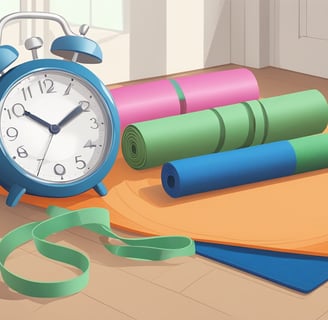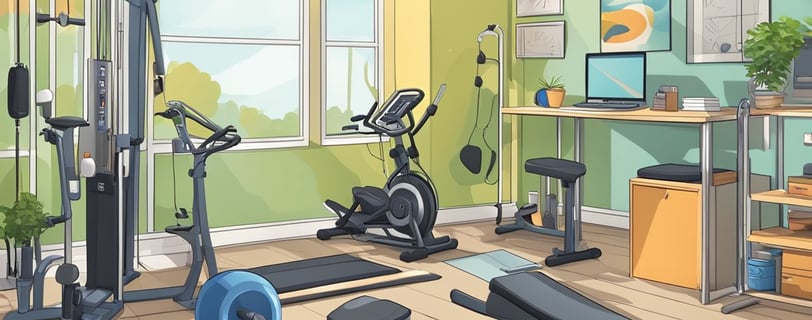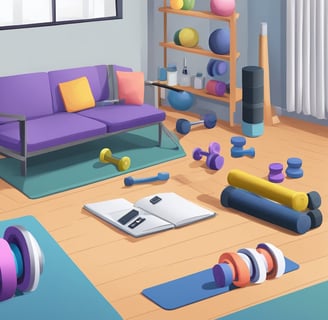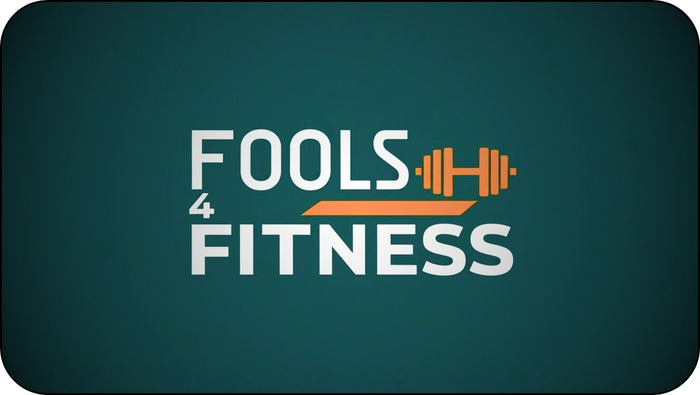10-Minute Fitness Workouts for Busy People: Quick Home Exercises That Deliver Results
Blog post description.
2/13/20255 min read


Time is precious, and finding spare hours to exercise can feel impossible. Many people think they need long gym sessions to get fit, but that's not true.
Just 10 minutes of focused exercise can improve strength, boost energy levels, and enhance overall health when done consistently. These quick workouts fit into even the busiest schedules, making fitness accessible for everyone.
Short workouts are perfect for lunch breaks, morning routines, or evening wind-downs. They require minimal equipment and can be done at home, in the office, or while traveling.
Key Takeaways
Short, intense workouts produce real fitness benefits when done regularly
Simple exercises using bodyweight or basic equipment create effective 10-minute routines
Consistency with brief daily workouts leads to better strength and health outcomes
The Philosophy of 10-Minute Workouts
Short, focused workouts can deliver significant results when done with proper intensity and form. The key lies in making every minute count through strategic exercise selection and efficient movement patterns.
Efficiency in Exercise
Time-efficient workouts focus on compound movements that work multiple muscle groups at once. These exercises burn more calories and build strength faster than isolated movements.
Smart exercise selection eliminates wasted time between sets. Moving quickly between exercises keeps the heart rate elevated and maximizes calorie burn.
Research shows that short, intense workouts can match or exceed the benefits of longer, moderate sessions. A study in the Journal of Physiology found that 10-minute high-intensity workouts improved endurance similar to 45-minute moderate sessions.
Maximizing Short Workout Benefits
The success of brief workouts depends on proper preparation and execution. Having equipment ready and a planned routine eliminates setup delays.
Maintaining proper form becomes crucial in shortened sessions. Each rep must be deliberate and controlled to prevent injury and ensure muscle engagement.
Key factors for effective short workouts:
Minimal rest periods (15-30 seconds)
Full range of motion on every rep
Focus on proper breathing
Progressive intensity increase over time
Strategic workout timing also matters. Morning sessions can boost metabolism for the day, while evening workouts can help reduce stress.
Designing Your 10-Minute Workout
A well-structured 10-minute workout combines essential movement patterns and targets different muscle groups for maximum benefits. The right plan matches your fitness level and goals while fitting into your daily schedule.
Components of a Balanced Routine
Every 10-minute workout needs three key parts: a 1-minute warm-up, 8 minutes of exercise, and a 1-minute cool-down.
The warm-up should include light marching in place or arm circles to prepare muscles for movement.
The main workout portion combines these basic movements:
2-3 lower body exercises (squats, lunges)
2-3 upper body moves (push-ups, arm circles)
1-2 core exercises (planks, crunches)
Each exercise takes 30-45 seconds with 15 seconds rest between moves.
Creating a Personalized Plan
Start by picking 4-6 exercises that match your fitness level. Beginners might choose basic squats and knee push-ups, while advanced exercisers can do jump squats and full push-ups.
Write down your chosen exercises and time intervals. A sample plan might look like this:
Warm-up: March in place (1 min)
Squats (45 sec)
Push-ups (45 sec)
Lunges (45 sec)
Mountain climbers (45 sec)
Cool-down: Light stretching (1 min)
Test the routine and adjust exercise times or movements based on how you feel. Make sure to track your progress and increase difficulty as exercises become easier.
Example Workouts for Different Fitness Levels
These 10-minute workouts adapt to any skill level and require no special equipment. Each workout focuses on key movements that build strength and cardio fitness at your own pace.
Beginner Workouts
Start with 30 seconds of work and 30 seconds of rest for each exercise:
March in place
Wall push-ups
Knee raises
Chair squats
Standing side bends
Repeat this circuit twice for a full 10-minute session. Focus on proper form rather than speed.
The exercises use basic movements that build core strength and stability. Take breaks when needed and maintain steady breathing throughout.
Intermediate Workouts
Perform each exercise for 40 seconds with 20 seconds of rest:
Jump rope (or jumping jacks)
Standard push-ups
Mountain climbers
Bodyweight squats
Plank holds
Complete this circuit two times. Add small jumps between exercises to keep heart rate elevated.
Mix cardio moves with strength training to maximize the workout's effectiveness. Keep movements controlled and maintain good posture.
Advanced Workouts
Execute each exercise for 45 seconds with 15 seconds of rest:
Burpees
Plyometric push-ups
High knees
Jump squats
Plank to downward dog
Run through the circuit twice at high intensity. Add complexity by combining movements into compound exercises.
Advanced moves require strong form and core stability. Use explosive power while maintaining control through each exercise.
Incorporating Equipment and Bodyweight
A mix of bodyweight movements and simple equipment creates effective 10-minute workouts that can be done anywhere. Both approaches offer unique benefits for building strength and improving fitness.
Using Bodyweight for Resistance
Push-ups, squats, and lunges form the foundation of equipment-free training. These movements target multiple muscle groups at once and can be modified for any fitness level.
A beginner might start with wall push-ups or assisted squats using a chair for balance. More advanced exercisers can try single-leg squats or decline push-ups.
Key Bodyweight Exercises:
Mountain climbers
Plank holds
Burpees
Jump squats
Bear crawls
Adding Equipment to Enhance Training
Light dumbbells and resistance bands add variety and challenge to quick workouts. A pair of 5-15 pound weights opens up many exercise options.
Simple Equipment Options:
Resistance bands
Light dumbbells
Kettlebells
Jump rope
Exercise mat
Resistance bands work well for upper body pulls and lateral movements. They're lightweight, portable, and can replace many machine exercises.
Equipment-based exercises like band rows or dumbbell shoulder presses complement bodyweight training. This combination creates balanced workouts that target all major muscle groups.
Tips for Consistency and Progress
Regular exercise habits and measuring results help create long-lasting fitness success. A strategic approach turns short workouts into sustainable lifestyle changes.
Fitting Workouts into a Busy Schedule
Set a specific time for exercise each day, like early morning before work or during lunch breaks. This creates a routine that becomes automatic.
Pack workout clothes the night before and keep them visible as a reminder. A gym bag by the door or exercise clothes laid out make it easier to stay on track.
Time-saving strategies:
Schedule workouts like important meetings
Use calendar reminders
Exercise at home to eliminate travel time
Break workouts into shorter sessions
Tracking Your Fitness Progress
Keep a simple workout log with exercises, sets, and weights used. This creates accountability and shows improvement over time.
Key measurements to record:
Number of repetitions
Weight lifted
Workout duration
Rest periods between sets
Take progress photos every 4-6 weeks. These visual records often reveal changes that aren't obvious day-to-day.
Use a fitness app to log workouts. Many free apps track exercises, provide workout ideas, and create graphs of progress.
Set small, measurable goals. Examples include doing one more push-up each week or holding a plank 5 seconds longer.










